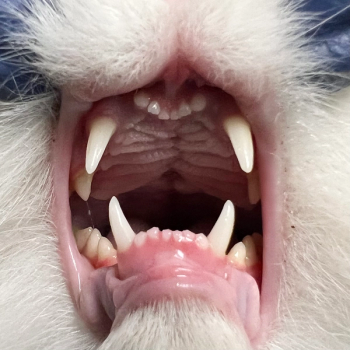
Retrievers and greyhounds (Proceedings)
Retrievers can have work-related conditions or they can have genetic conditions. A common work-related problem is related to overheating. A medical condition seen in Labrador Retrievers is Exercise-induced Collapse.
Retrievers
Retrievers can have work-related conditions or they can have genetic conditions. A common work-related problem is related to overheating. A medical condition seen in Labrador Retrievers is Exercise-induced Collapse.
Overheating is also called hyperthermia, heat prostration, and heat stroke. There is an inability of the body to regulate its temperature. The heat produced by the body is greater than the body's heat dissipation. The causes of hyperthermia include lack of conditioning, lack of acclimatization, high humidity, high temperature, too much exercise too soon, obesity, and previous overheating episodes. The clinical signs of overheating are panting, extreme hyperventilation, hypersalivation, altered mentation (glassy eyed), ataxia, muscle weakness, vomiting, diarrhea, weakness and collapse. All of the body's systems can be damaged. Other problems associated with hyperthermia are disseminated intravascular coagulation (DIC), adult respiratory distress syndrome (ARDS) severe electrolyte abnormalities. Basically the internal tissues can be cooked.
Overheating in the field is a scary situation, and time is of the essence. It is best to educate the clients that have athletic or working dogs on how to handle dogs with hyperthermia. They must understand that the most important thing to do is to get to the veterinarian. The longer the body is exposed to high temperatures the more damage is done. Too many dogs have suffered brain damage or have died because of futile attempts to treat in the field. The cause of death wasn't the initial heat exhaustion itself, but the secondary damage to the kidneys resulting in kidney failure. In a lot of these cases the dog would have been much better served if the top priority had been to initiate the trip to the veterinarian. The cooling down treatments could have been performed during the trip to the veterinarian and therapy could have been provided at an earlier stage of the emergency. Immediate treatment for this condition is a cool water bath or spray, ice applied to the abdomen, and/or blow a vehicle air conditioner or fan on the dog's body. Cool the body to around 103 degrees and the stop. If cooling measures are continued after this, the body's temperature will continue to drop. This will result in a hypothermic state.
Once the veterinarian receives the case, start to cool the dog down, insert an intravenous (IV) catheter and begin to determine the dog's status. Corticosteroids (dexamethasone) given IV at a shock dose of 1 mg per pound have shown to be of benefit in most cases. It is important to monitor the kidney function of the dog. It is common for a dog to recover from the hyperthermic event and then succumb to kidney failure.
Medical conditions caused by exercise are now starting to be identified. It is not clear if we are now just starting to identify problems that have been there fro a long time or if these conditions are now starting to appear because the work level of dogs has recently started to increase. Currently the most common example of an exercise induced medical problem is in Labrador Retrievers. Exercise induced collapse (EIC) is a condition in certain Labrador retrievers where after about 5-15 minutes of exercise these dogs start to loose control of their rear limbs. Some of the dogs will progress to the point that their body will totally collapse. There have been instances where the dog will get so bad that death is the end result. In most cases, if the handler stops the work at the first sign of an episode and then rests the dog for 10 – 15 minutes, the dog will return to normal. At this time there is no definitive treatment for this condition. It is very important that the veterinary clinician rule out other medical conditions before actually diagnosing a Labrador Retriever with this problem because it has recently been shown that other medical conditions that can be treated will exhibit clinical signs similar to EIC. Two other conditions that have been reported to occur on a rare occasion are Exercise induced seizures and Phosphofructokinase deficiency.
Greyhounds
Today's general practitioner is now seeing more greyhounds than they did ten years past. The breed does have some medical conditions that are not seen in the general pet population. There is still a large population of the traditional racing greyhounds that can present with medical conditions related to their sport. In addition, a lot of the retired greyhounds are actively participating in lure coursing or other sporting events.
Exertional Rhabdomyolysis is a metabolic disease that affects athletic and working dogs. It is related to extreme muscle work to the point that the muscle cells are damaged. This cellular damage can create secondary problems that can range from minor muscle pain to the death of the dog. It is seen in Sled Dogs, Racing Greyhounds, bird dogs, coursing dogs and field and trial competitors. Greyhound and Sled Dog Veterinarians deal with this problem much more commonly than the general practitioner. In the general veterinary practice this will be seen occasionally in the pet dog that has gotten out and run away. The references for understanding and handling this problem are minimal in the canine veterinary literature. It is well documented in equine medicine, and has recently been a topic in the human literature. Exertional rhabdomyolysis is also known as tying up, Monday morning sickness, azoturia, or muscle cramps.
Two scenarios produce its occurrence in the athletic and working dog. Unfit dogs taken to a race or trial and forced to run several heats over a short period of time is a common precursor to the problem. The other scenario involves a conditioned dog that runs above its normal activity level. An example is a "dog escape" where the dog runs free for a distance for which it is not conditioned to run. At the racetrack this is seen when there is a problem with the stopping area of the lure system. If the Greyhound ends up running further than the normal race distance (i.e. twice around the track), rhabdomyolysis is a common result. This syndrome is sometimes described as "running the back off" the dog, because the muscles most affected by the problem are the lumbar muscles groups. The name comes from the dramatic reduction in the size of the lumbar muscle groups after one of these bouts. "Sled-dog myopathy" is a term used in the sled dog world. It can be a result of both predisposing scenarios. Either a dog is not condition properly to run the race or a conditioned dog is put in a situation where the demands of the situation are above their physical capabilities. The literature states that it is usually seen in the first 400 km of a race. A correlation can be seen to blood CK levels. In the Iditarod sled dog race, the CK levels were reported to be elevated in the first 400 miles of the race, but returned to normal by the end of the race. The musher can certainly come into unforeseen situations where the weather or terrain presents conditions that could never have been planned for in their pre-race conditioning program.
Two additional environmental and managerial circumstances seem to predispose Greyhounds to exertional rhabdomyolysis. One is the tendency of highly-strung Greyhounds to become very tense and excitable prior to running. The other is a hot and humid climatic condition during traveling or in pre-race kenneling where climatic factors are not controlled.
Many greyhounds can have an underlying ehrlichiosis infection. They do not seem to be affected by the disease whereas other breeds can have various levels of reaction. Canine ehrlichiosis is a tick-borne rickettsial blood disease of domestic and wild canids. The disease may be presented as acute, subclinical, chronic, or severe chronic in form. Clinical signs may never be apparent in the greyhound so the big issue is the dogs that are housed with the greyhound. For this reason, all greyhounds should be checked for this pathogen.
The metabolism of the greyhound, as well as the other sighthounds, is somewhat different than the other breeds. For this reason they can be predisposed to medical problems not seen in the other breeds.
Newsletter
From exam room tips to practice management insights, get trusted veterinary news delivered straight to your inbox—subscribe to dvm360.






